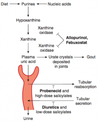Musculoskeletal Drugs Flashcards
What is the pathways for AA?
What is the starting product?
Where does it go to next?
Start with membrane lipid ( phophatidylinositoly)
lipid—> (Phospholipase A2) –> Arachidonic Acid
What different paths can Arachidonic Acid head down?
What enZs do that?
What drugs inhibit those enzymes?
AA—> (Lipoxygenase)—> Hydorperoxidase ( HPETES) that go to LeukoT
Zieluton inhibits Lipoxygenase
OR
AA–> (COX1 and 2)–> Endoperoxides (PGG2, PGH2)
NSAIDs/aspirin/actaminophen/ COX-2 inhitors block COX1 and 2
What drugs inhibit COX 1 and COX 2?
Corticosteroids
NSAIDS, aspirin, acetominophen, COX-2 inhibitors
Thus can’t make Prostacyclines (PGI2)
Can’t make Prostaglandins (PGE2, PGF2)
Can’t make Thormoboxane (TXA)
What is the Starting point of the AA cycle
What does it genererate?
Via what pathways

Start with lipid membrane —> Phospholipase A2 to AA
Then can head down lipoxygeanse path to make Leukotrienes
OR
Head down the COX1 and 2 path to amke TXA2, Prostaglandins: PGE2, PGF2 and Prostacyclines: PGI2
What drug can inhibit the progression for LTC4, LTD4 and LTE4 which causes
INCREASED bronchial tone
Zarfirlukast and Montelukast block receptor for LCT, LTD and LTE
What is the role of the following:
LTB4:
LTC4, LTD4, LTE4:
LTB4: Neutrophil chemotaxis
LTC4, LTD4, LTE4: Increase bronchial tone (blocked by Zeiluton or Monteclast)

What are the restuls of the following products
Prostacyclin : PGI2
Prostaglandin: PGE2 and PGF2
Thromboxane: TXA
Prostacyclin : PGI2 –> Low plat aggregation, low vascular tone, low bronchial tone, low uterine tone
Prostaglandin: PGE2 and PGF2–> Increased uterine tone and decrease bronchial tone
Thromboxane: TXA: Increase plat aggregation, increase vascular tone, increase bronchial tone

______ is a neutrophil chemotactic agent.
_____ inhibits platelet aggregation and promotes vasodilation.
LTB4
PGI2
what is the mechanism of Acetaminophen?
Where does it act?
What is it used for?
Reversibly inhibits cyclooxygenase, mostly in CNS. Inactivated peripherally.
Antipyretic, analgesic, but not anti-inflammatory.
Used instead of aspirin to avoid Reye syndrome in children with viral infection
What drug would we use for child with fever and aches?
What’s it’s mechanims?
Use Acetominophen
irreversible inhibits COX and safer choice over aspirin
What toxicity is associated with Acetominophen?
What organ?
What is the antidote?
Overdose produces hepatic necrosis; acetaminophen metabolite (NAPQI) depletes glutathione and forms toxic tissue byproducts in liver.
N-acetylcysteine is antidote—regenerates glutathione.

Irreversibly inhibits cyclooxygenase (both COX-1 and COX-2) via acetylation, which decreases synthesis of TXA2 and prostaglandins.
Increased bleeding time. No effect on PT, PTT. A type of NSAID.
Aspirin
What is the difference between low dose, intermediate dose and high dose Aspirin
Low dose (< 300 mg/day): platelet aggregation.
Intermediate dose (300–2400 mg/day): antipyretic and analgesic.
High dose (2400–4000 mg/day): anti-inflammatory.
What is the mechanism of Aspirin?
Irreversibly inhibits cyclooxygenase (both COX-1 and COX-2) via acetylation, which increase synthesis of TXA2 and prostaglandins.bleeding time. No effect on PT, PTT. A type of NSAID.
What toxicity is associated with Aspirin?
Gastric ulceration, tinnitus (CN VIII). Chronic use can lead to acute renal failure, interstitial nephritis, GI bleeding.
Risk of Reye syndrome in children tr_eated with aspirin for viral in_fection. Causes respiratory alkalosis early, but transitions to mixed metabolic acidosis-respiratory alkalosis








